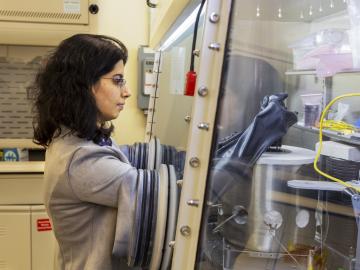
Filter News
Area of Research
News Topics
- (-) Materials (45)
- 3-D Printing/Advanced Manufacturing (36)
- Advanced Reactors (5)
- Artificial Intelligence (29)
- Big Data (13)
- Bioenergy (23)
- Biology (34)
- Biomedical (15)
- Biotechnology (10)
- Buildings (26)
- Chemical Sciences (19)
- Clean Water (11)
- Climate Change (30)
- Composites (10)
- Computer Science (48)
- Coronavirus (10)
- Critical Materials (7)
- Cybersecurity (5)
- Decarbonization (27)
- Education (1)
- Emergency (1)
- Energy Storage (30)
- Environment (57)
- Exascale Computing (7)
- Fossil Energy (2)
- Frontier (10)
- Fusion (12)
- Grid (17)
- High-Performance Computing (32)
- Isotopes (23)
- ITER (5)
- Machine Learning (9)
- Materials Science (35)
- Mathematics (3)
- Mercury (3)
- Microscopy (12)
- Nanotechnology (12)
- National Security (20)
- Net Zero (6)
- Neutron Science (28)
- Nuclear Energy (13)
- Partnerships (11)
- Physics (7)
- Polymers (10)
- Quantum Computing (15)
- Quantum Science (24)
- Security (5)
- Simulation (12)
- Space Exploration (7)
- Statistics (3)
- Summit (13)
- Sustainable Energy (51)
- Transportation (33)
Media Contacts

ORNL’s Janet Meier won the Energy Security category of the U.S. Department of Energy’s inaugural National Lab Research SLAM on Capitol Hill.

Rigoberto “Gobet” Advincula, a scientist at the Department of Energy’s Oak Ridge National Laboratory, has been appointed a Fellow of the Institute of Materials, Minerals and Mining.

Corning uses neutron scattering to study the stability of different types of glass. Recently, researchers for the company have found that understanding the stability of the rings of atoms in glass materials can help predict the performance of glass products.

ORNL and Tuskegee University have formed a partnership to develop new biodegradable materials for use in buildings, transportation and biomedical applications.

A discovery by Oak Ridge National Laboratory researchers may aid the design of materials that better manage heat.

Oak Ridge National Laboratory researchers determined that designing polymers specifically with upcycling in mind could reduce future plastic waste considerably and facilitate a circular economy where the material is used repeatedly.

A new technology for rare-earth elements chemical separation has been licensed to Marshallton Research Laboratories, a North Carolina-based manufacturer of organic chemicals for a range of industries.

Researchers at the Department of Energy’s Oak Ridge, Brookhaven and Idaho national laboratories and Stony Brook University have developed a novel approach to gain fundamental insights into molten salts, a heat transfer medium important to advanced

Ten scientists from the Department of Energy’s Oak Ridge National Laboratory are among the world’s most highly cited researchers, according to a bibliometric analysis conducted by the scientific publication analytics firm Clarivate.

Amy Elliott, a group leader for robotics and intelligent systems at Oak Ridge National Laboratory, has received the 2021 ASTM International Additive Manufacturing Young Professional Award for her early career research contributions


